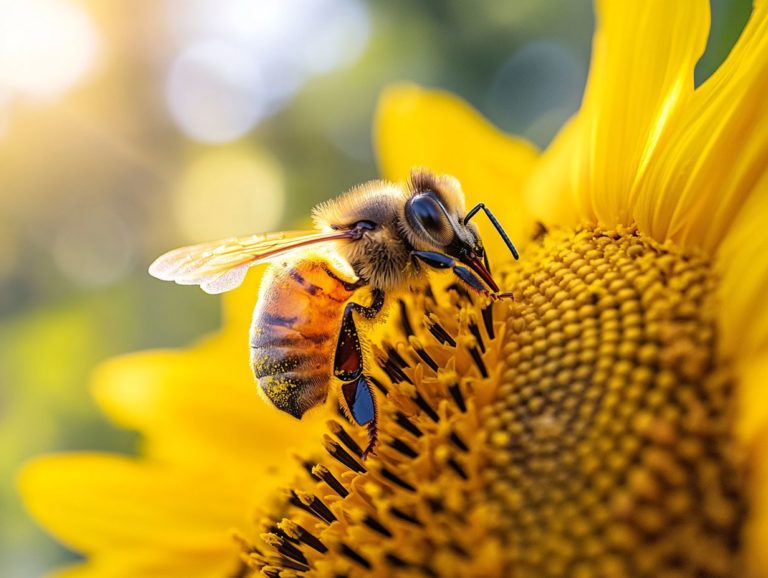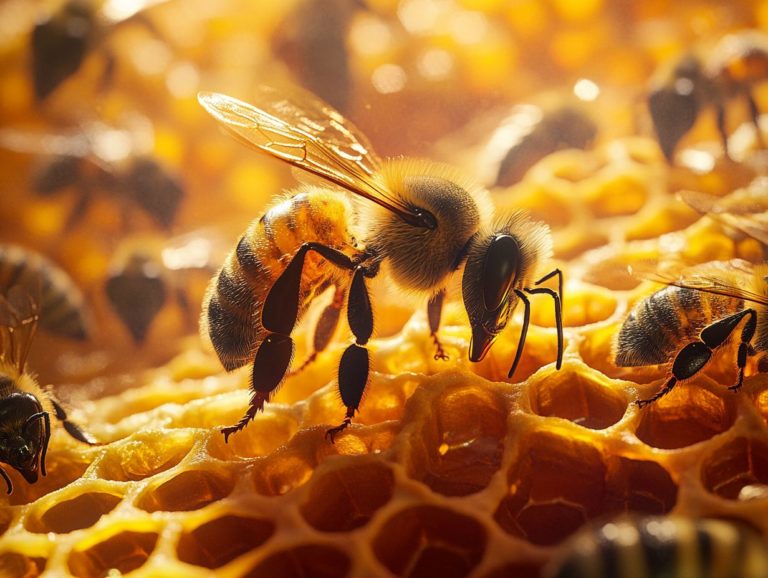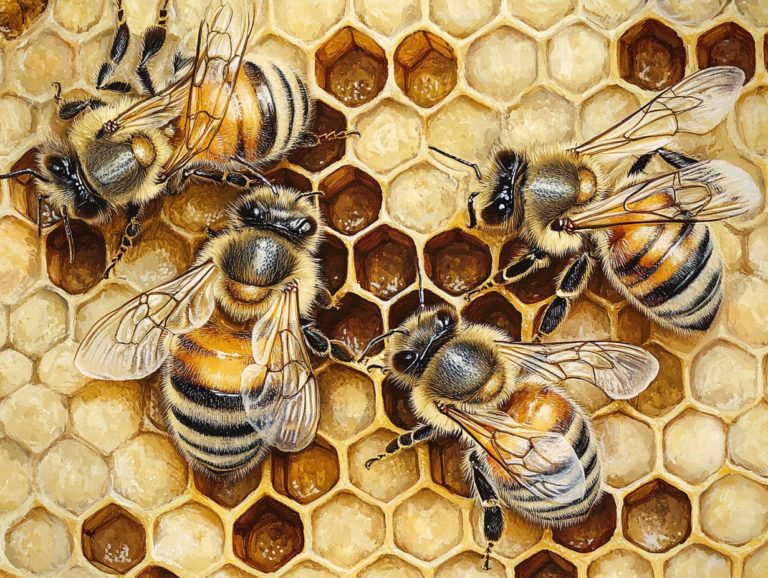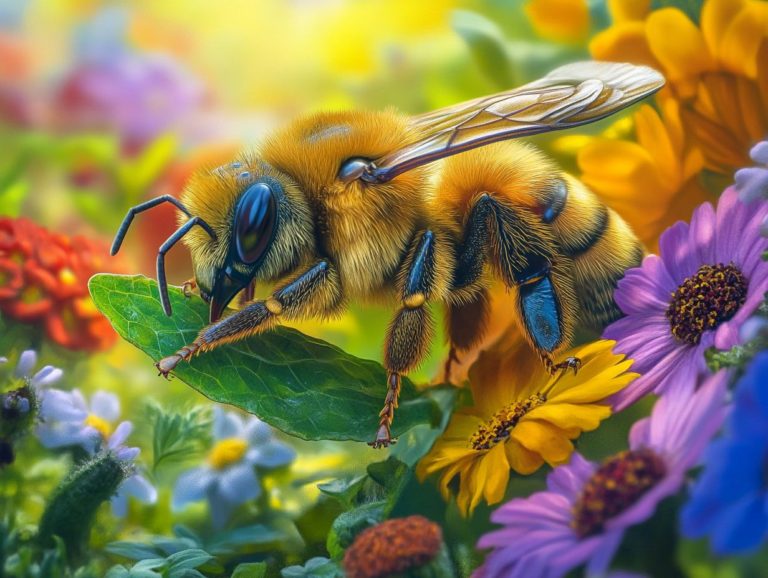How Bees Navigate Their Environment
Bees are truly remarkable creatures, renowned not only for their essential role in pollination but also for their extraordinary navigation skills.
Bees use unique sensory mechanisms to navigate complex environments. These mechanisms include magnetic field detection, polarization vision, and sun navigation.
But bees don t navigate in isolation; they share crucial details about their foraging escapades through intricate behaviors like the waggle dance and pheromone signaling.
Let s dive into the fascinating ways bees navigate and communicate, the various types of navigation they employ, and the factors that shape their journeys. Join scientists as they unveil the secrets of these incredible navigators, revealing the extraordinary world of bee navigation!
Contents
- Key Takeaways:
- How Do Bees Sense Direction?
- How Do Bees Communicate and Share Information?
- What Are the Different Types of Bee Navigation?
- What Factors Affect Bee Navigation?
- How Do Humans Study Honeybee Navigation?
- Frequently Asked Questions
- What is the role of dance in how bees navigate their environment?
- How do bees use the sun to navigate their environment?
- Do bees have a sense of direction?
- What is the importance of memory in how bees navigate their environment?
- How do bees communicate with each other while navigating their environment?
- Are honeybees affected by changes in their environment?
Key Takeaways:
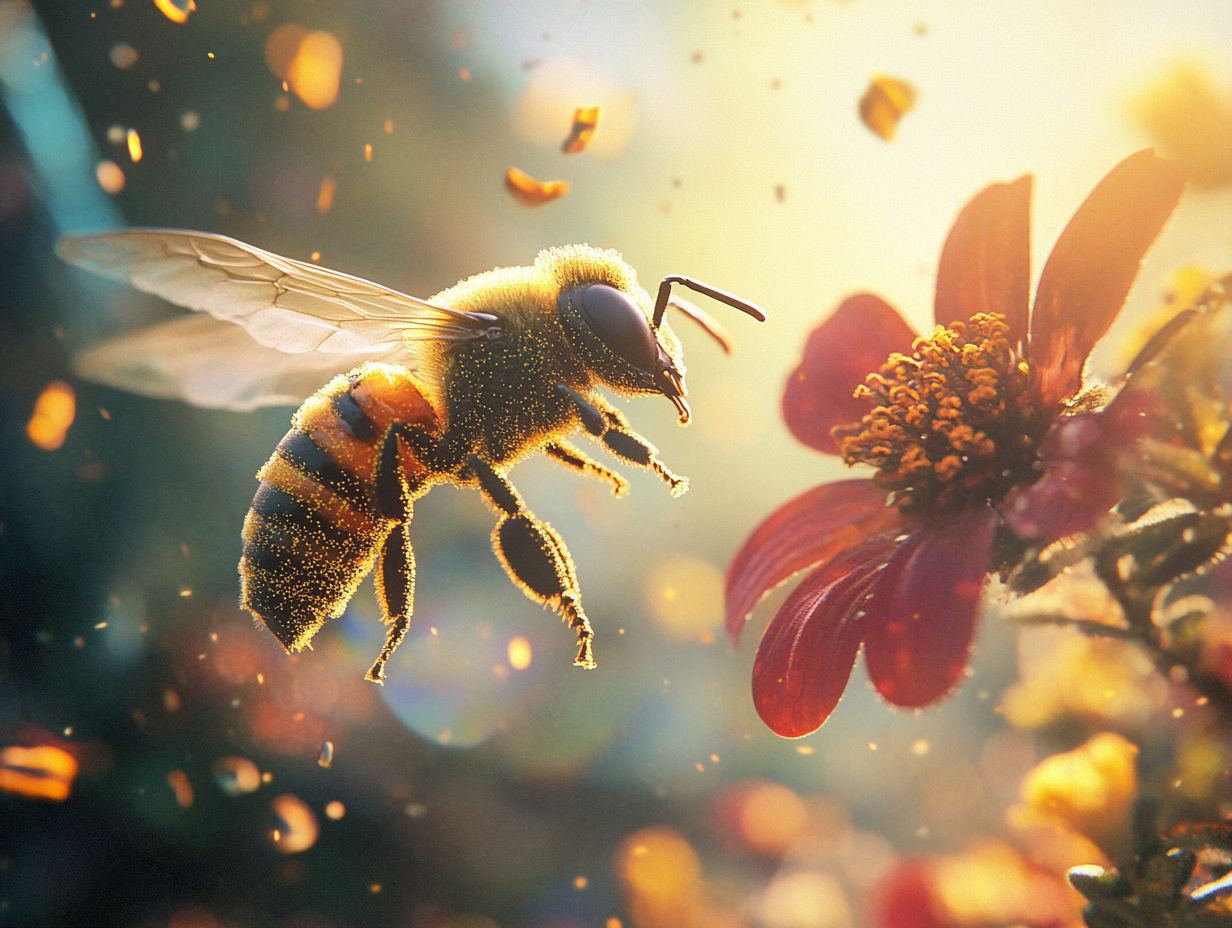
- Bees have a unique sense of direction using magnetic fields, polarization vision, and the sun.
- They communicate and share information through the waggle dance and pheromones.
- Different types of bee navigation include homing and foraging, which are affected by factors such as weather, time of day, and distance.
How Do Bees Sense Direction?
Bees, especially honeybees (Apis mellifera), exhibit remarkable navigation abilities that enable them to adeptly sense direction in their surroundings. Researchers, including distinguished experts like Menzel from the Free University of Berlin, have thoroughly investigated how these extraordinary pollinators utilize a range of sensory modalities for orientation.
By harnessing a blend of mental maps, visual input, and environmental cues, bees skillfully navigate through intricate landscapes, ensuring they can return home after embarking on exploratory flights in search of nectar and pollen grains.
1. Magnetic Field Detection
Magnetic field detection is an intriguing navigation strategy that you can observe in bees as they navigate the expansive landscapes they encounter.
With their highly developed sensory skills, including small, simple eyes known as ocelli, bees possess the extraordinary ability to perceive magnetic fields. This sensory processing is pivotal, allowing them to orient themselves during foraging missions and effectively navigate through complex environments filled with a rich diversity of flora and varying terrain.
By integrating this magnetic information with their cognitive abilities, bees enhance their decision-making processes, which enables them to remember the locations of food sources and return efficiently to their hives. These remarkable skills not only contribute to individual foraging success but also play a crucial role in the overall health of the colony, ensuring that they thrive under a variety of conditions.
2. Polarization Vision
You may be fascinated to learn that bees possess a remarkable ability known as polarization vision, enabling them to interpret the orientation of light in their surroundings. This extraordinary skill allows these insects to detect partially polarized light reflected from the sky, helping them pinpoint the sun’s position, even on overcast days.
In the intricate landscapes they navigate, filled with myriad visual cues such as vibrant flowers, towering trees, and diverse terrains, this sensory modality proves invaluable. It enhances their navigation skills by providing a dependable reference point, allowing bees to construct mental maps of their environment. By interpreting the subtle shifts in polarized light, they can efficiently locate food sources and make their way back to the hive, significantly reducing the chances of getting lost amid potential distractions.
Sun navigation stands out as a vital technique that bees employ to navigate adeptly during their foraging flights. By recognizing the position of the sun in the sky, you can appreciate how these remarkable creatures determine the direction to their food sources. As the sun shifts throughout the day, bees exhibit impressive adaptability in their navigation strategies.
They skillfully adjust their flight paths by using the angle of sunlight. They also use their internal body clock to keep track of the sun’s movement. Furthermore, they utilize environmental cues such as prominent landmarks or the delightful scent of flowers to enhance their orientation.
These smart ways not only boost their foraging efficiency but also ensure they return home safely. This truly showcases the remarkable complexity of their navigational abilities.
4. Sense of Smell
The sense of smell in bees is essential for their navigation. It allows you to appreciate how they detect chemical signals and pheromones in their environment. This remarkable olfactory ability is crucial for foraging, as bees rely on these chemical signals to identify flower scents and efficiently locate food sources.
You ll find that bees can recognize specific aromatic compounds that indicate the presence of nectar. This skillfully guides them from one bloom to another while enhancing the pollination process. Their detection capabilities also assist in navigating familiar landscapes and enable them to create mental maps of their territory. This ensures they can reliably return to their hive after foraging.
Without this sophisticated sense of smell, bees would face immediate challenges in thriving. This underscores the vital connection between chemical detection and their survival in diverse ecosystems.
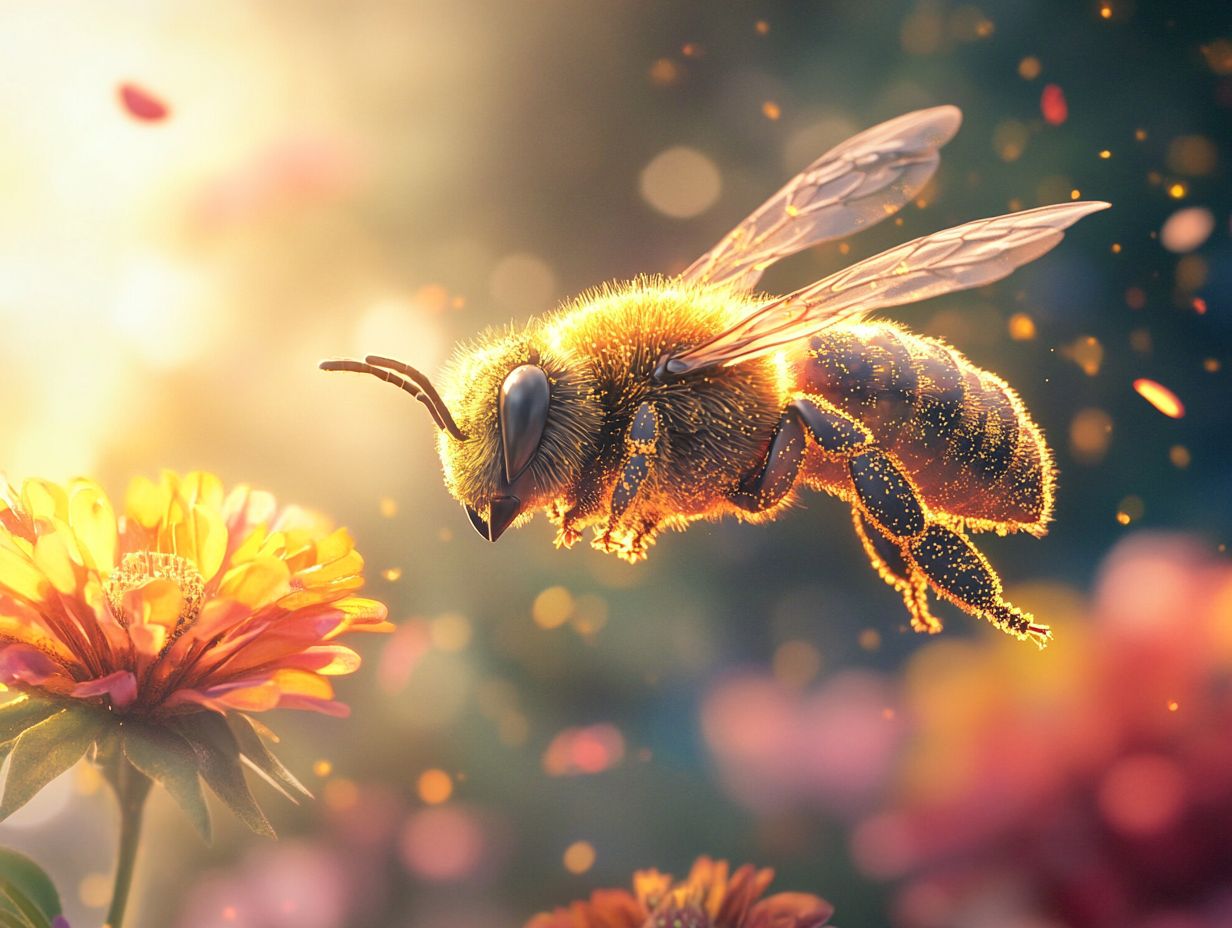
Bees possess remarkably intricate communication methods that allow them to share essential information about food sources and navigation strategies with their colony members.
With behaviors like the waggle dance and the use of chemical signals such as pheromones, bees adeptly convey important details regarding the locations of nectar, optimal foraging routes, and shifts in their environment.
This sophisticated communication system is vital for their survival as pollinators across diverse habitats.
1. Waggle Dance
Watch how this amazing dance shows bees communicating the location of food sources to their fellow colony members. This intricate dance showcases a series of precise movements, where the dancer bee waggles its body while moving in a figure-eight pattern.
The duration of the waggle phase is particularly telling: longer waggles indicate that the food source is located farther from the hive. The angle at which the bee waggles in relation to the vertical comb serves as a compass, guiding other bees in the direction they should fly relative to the sun.
This remarkable method of navigation not only helps individual workers locate resources but also fosters a cooperative spirit within the hive. It underscores the vital importance of communication in collective foraging efforts.
2. Pheromones
Pheromones are crucial chemical signals in bee communication, enabling you to share vital information about various aspects of your environment.
These chemical signals are essential not only for navigation but also for coordinating foraging behavior and maintaining the social structure within the colony. When bees sense danger, worker bees release alarm pheromones, alerting others to potential threats.
Meanwhile, forager bees communicate the location of food sources through a captivating blend of pheromones and intricate dance movements. The queen plays a vital role, producing specific pheromones that help maintain harmony and cohesion within the hive, effectively guiding the dynamics of the colony.
By understanding these diverse pheromonal cues, you gain insight into how these remarkable creatures make collective decisions and optimize their survival strategies in the ever-evolving landscape of their environments.
Bees utilize a range of navigation strategies that can be broadly classified into two primary types: homing navigation and foraging navigation. Homing navigation is designed to guide bees back to their hive after their foraging adventures, while foraging navigation enables them to seek out and identify new food sources.
These navigation methods play a vital role in the ecological strategies that bees employ, underscoring their importance as essential pollinators in their ecosystems.
Imagine a bee darting through the air, expertly finding its way home! Homing navigation is essential for you to understand how bees accurately find their way back to their hive after foraging flights.
To accomplish this extraordinary task, bees create a detailed mental map of their environment, enabling them to identify key landmarks and directional cues. These remarkable creatures rely on visual signals, like prominent trees, buildings, or even changes in terrain, to construct a mental representation of their surroundings. By committing these reference points to memory, bees can expertly orient themselves as they embark on their journey home.
This advanced navigation system not only supports efficient foraging but also ensures their safe return. This highlights the incredible cognitive abilities and adaptability of honeybees.
Foraging navigation is all about the strategies that honeybees use to locate and gather food resources from their surroundings.
These remarkable insects employ a blend of environmental cues like landmarks, the position of the sun, and scent trails to maximize their foraging efficiency. As foraging honeybees embark on exploratory flights, they venture out from the hive, diligently mapping their environment and noting the locations of flowering plants brimming with nectar and pollen. This exploration helps bees collect food quickly. It also builds a mental map of their ecosystem, forming a complex spatial representation.
Bees possess an impressive memory of space, enabling them to return time and again to the most rewarding sources. This behavior significantly contributes to the balance and biodiversity of the ecosystem through their foraging patterns.
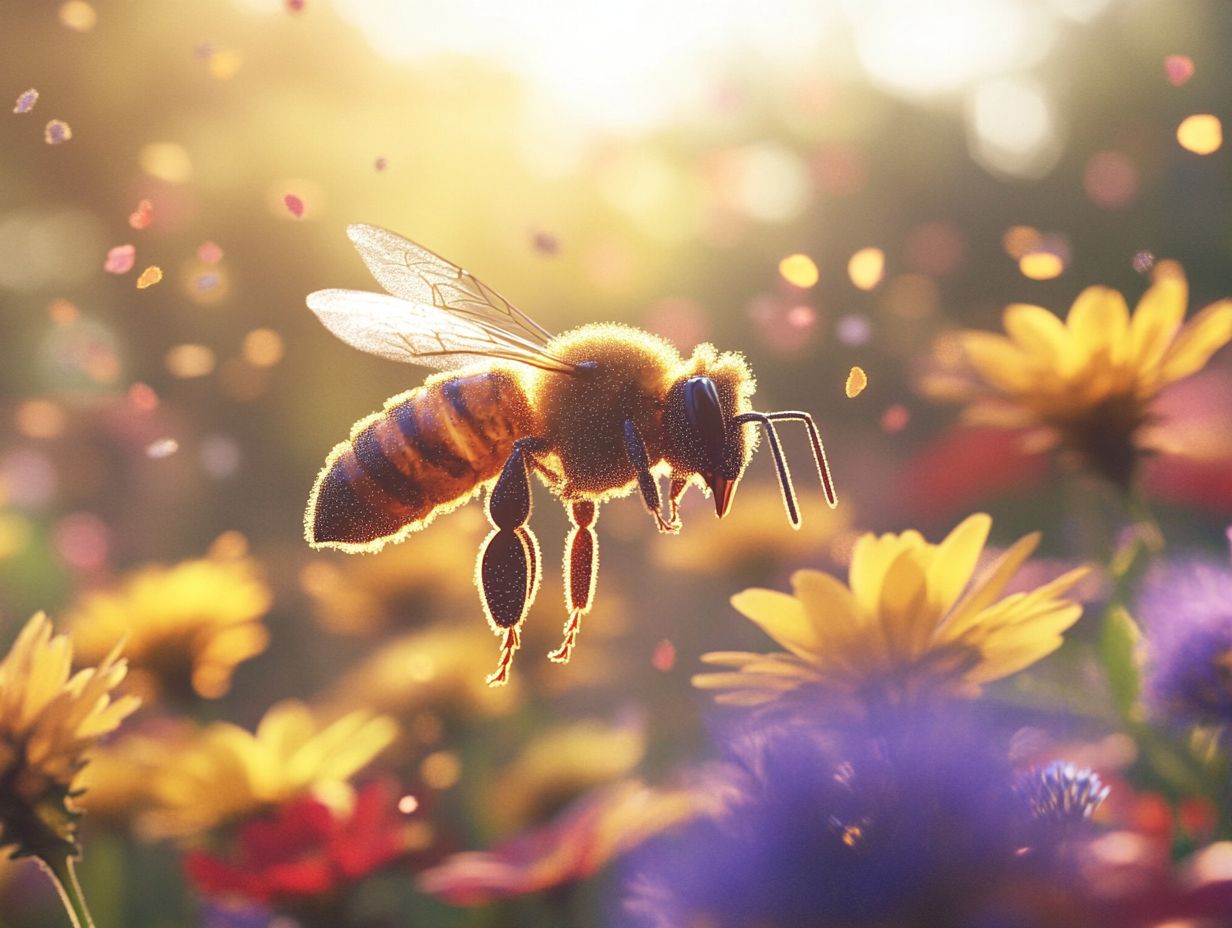
Several factors can profoundly influence bee navigation, affecting their ability to navigate back to the hive. Weather conditions, including wind and temperature, are crucial elements in their navigation strategy, while the time of day significantly affects light availability and foraging activity. The home area and exploratory flights are also essential components of their navigation process.
Furthermore, the distance traveled during exploratory flights can impact their overall navigation accuracy, underscoring the necessity for bees to adapt adeptly to their environment.
1. Weather
Weather conditions significantly impact bee navigation, shaping their foraging behavior and determining their success in locating food sources. Even irrigation channels can alter the landscape, affecting their flight patterns and foraging efficiency.
For instance, consider how wind speed and direction can present considerable challenges; strong gusts may compel bees to alter their flight paths or curtail their foraging time. Similarly, rain can obscure visual landmarks, complicating their ability to form cognitive maps of their surroundings. Temperature fluctuations not only affect the blooming times of plants but also influence the bees metabolic activities, thereby impacting how long they can sustain their foraging flights.
These weather elements are critical for bees’ survival! They play an essential role in determining the efficiency and effectiveness of bees in their pursuit of nectar and pollen, intricately linking their survival to the prevailing environmental conditions.
2. Time of Day
The time of day significantly influences the navigation of honeybees, shaping their foraging patterns and overall activity levels.
As daylight unfolds, these industrious insects spring into action, engaging in their vital foraging activities. They skillfully utilize the sun’s position and the light’s intensity to enhance their navigational prowess.
The sensitivity of their photoreceptors shifts with changes in light availability, allowing them to detect floral cues and geographical landmarks more effectively when conditions are bright.
Research indicates that bees rely heavily on their circadian rhythms to align their foraging efforts with peak floral availability. This alignment boosts their efficiency in pollination. Fluctuations in these rhythms can greatly impact their foraging abilities across different seasons.
This highlights the intricate relationship between environmental factors, such as light availability, and the sensory modalities that guide their remarkable foraging behavior.
3. Distance
The distance you travel during exploratory flights can present challenges for navigation, impacting your ability to accurately return to the hive. Distance neurons and speed neurons play critical roles in processing these navigational tasks.
As you venture further, your mental maps representations of your surroundings become essential for efficient navigation.
Research shows that as you fly farther, familiar landmarks like trees, hills, or even human-made structures become your trusty guides.
Along with these visual cues, you use the sun’s position and polarized light, which is sunlight filtered to vibrate in a certain direction, as navigational aids.
In complex environments, these strategies help you counter disorientation. Your ability to memorize and recognize these landmarks is crucial; losing familiar reference points can significantly hinder your return journey.
The interlandmark context is essential for maintaining orientation. Understanding how distance affects your navigational skills can improve our efforts in conserving bee habitats and enhancing foraging success.
This exciting research highlights how crucial linear landscape elements, like hedgerows and irrigation channels, are for navigation.
You may be intrigued to know that researchers from the Free University of Berlin have devised numerous methods to study honeybee navigation. They employ a mix of observation, experimentation, and cutting-edge technology to unravel the secrets of how these extraordinary pollinators orient themselves.
Techniques such as radar tracking and innovative experimental setups, including transponder usage, have yielded invaluable insights into the flight patterns and cognitive strategies that honeybees utilize as they traverse intricate landscapes.
For example, Menzel’s research highlights the role of transponders in tracking individual bees within an experimental area. Studies in Brandenburg and Klein L ben have played a pivotal role in enhancing our understanding of honeybee navigation.
1. Observation
Observation serves as a fundamental method for studying honeybee navigation and gaining insights into their behavioral patterns in natural settings.
This technique enables you to gather valuable information about how these remarkable insects interpret their environment, communicate with each other, and efficiently find their way back to the hive.
Key findings from various studies reveal that honeybees utilize a combination of visual cues and celestial navigation to orient themselves, showcasing a sophisticated understanding of their surroundings.
They particularly rely on visual input and mental maps to navigate effectively. By carefully observing their flight paths, you can uncover intriguing details about their foraging behavior and the dancing language they employ to convey information about food sources.
Such insights not only deepen your understanding of honeybee ecology but also play a crucial role in informing conservation efforts aimed at preserving these essential pollinators and the ecosystems they sustain.
Join us in protecting bee habitats to ensure these amazing creatures continue to thrive!
2. Experiments
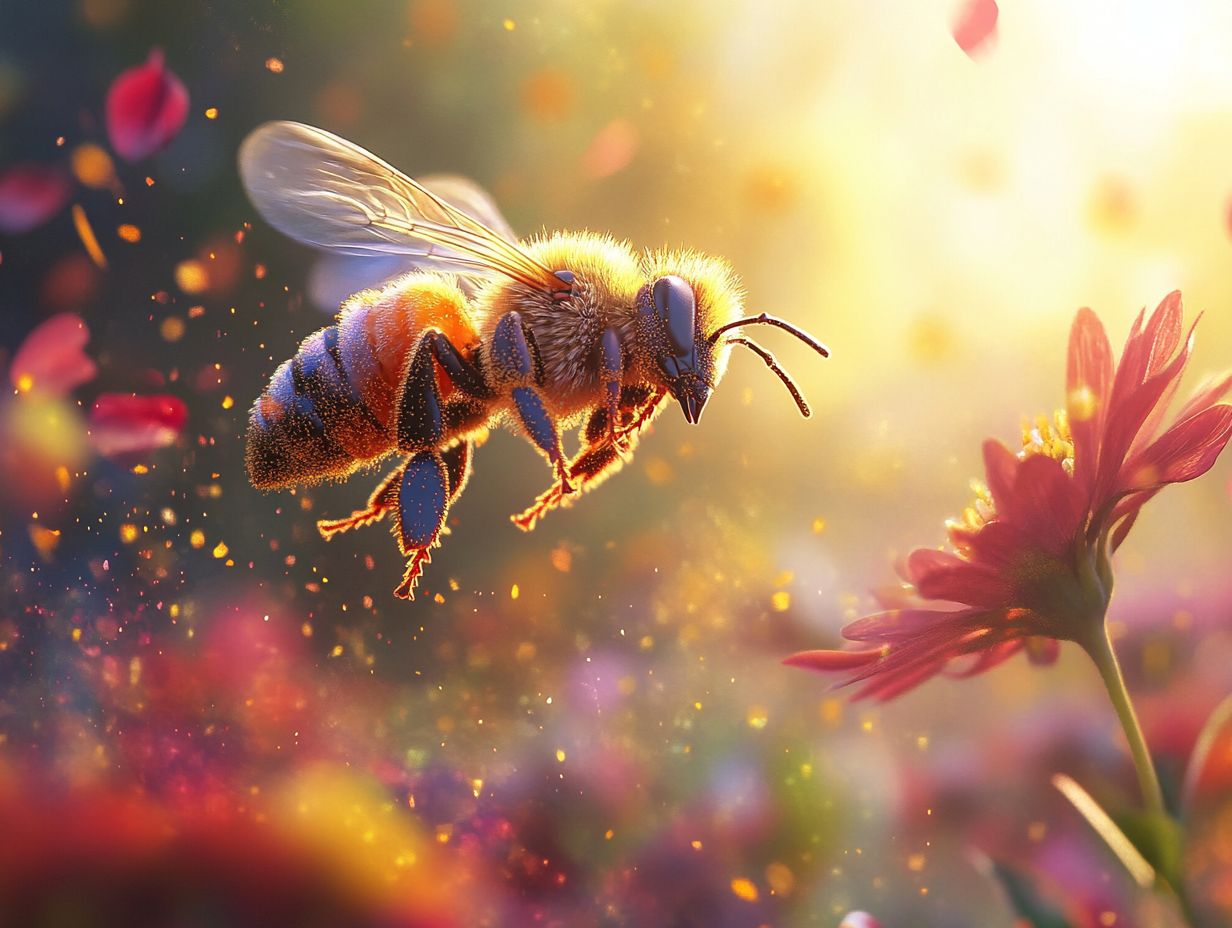
Experiments are essential for gaining insights into the fascinating mechanisms of honeybee navigation. They enable you to manipulate variables and observe their effects on foraging and homing behaviors.
By utilizing advanced techniques like transponders devices that send signals to track bees you can meticulously track the movements of individual honeybees as they navigate through diverse landscapes. Controlled environments, such as flight tunnels and simulated floral settings, offer a rich context for understanding how bees rely on visual and olfactory cues to find their way.
Exciting results from these experiments reveal the amazing skills honeybees use to navigate! They highlight the importance of sunlight’s polarization patterns for orientation and showcase the remarkable ability of honeybees to learn and remember spatial relationships. Your studies illuminate the intricate interplay between genetic factors and environmental influences, deepening your understanding of the navigation strategies employed by these vital pollinators. Researchers have found that cognitive abilities and self-awareness play a key role in honeybee navigation.
3. Technology
Advancements in technology have dramatically transformed the study of honeybee navigation. You are now equipped with remarkable tools such as radar and machine learning to delve into the complexities of their flight patterns.
These innovations allow you to track honeybee movements with an unparalleled level of precision. This uncovers intricate details about how bees orient themselves within their surroundings. By utilizing radar tracking systems, you can amass extensive data on the flight trajectories of various bee species, which can then be analyzed through sophisticated algorithms. This approach enhances your understanding of the sensory mechanisms bees rely on for navigation like visual cues and chemical signals they use to communicate.
As you explore the nuances of honeybee behavior and their habitat requirements, these insights could play a crucial role in shaping conservation strategies designed to protect vital pollinator populations amid environmental changes.
Frequently Asked Questions
Honeybees use a dance known as the “waggle dance” to communicate the location of food sources to other bees. The vibrations produced during these dances help relay spatial information effectively.
Honeybees have specialized cells in their eyes known as ocelli that allow them to detect the position of the sun and use it as a point of reference for navigation. This directional reference is crucial for their foraging success.
Do bees have a sense of direction?
Absolutely! Honeybees are master navigators, using the sun, landmarks, and other bees’ dances to expertly find their way. Their memory and ability to recognize familiar landmarks enhance their orientation skills.
Honeybees have great memory and can remember the location of food sources even after several days. This helps them navigate their environment more efficiently. This visual memory is crucial for their foraging efficiency and pollination activities.
Apart from the waggle dance, honeybees also use pheromones and vibrations to communicate with each other while navigating their environment, employing various sensory modalities and environmental cues.
Are honeybees affected by changes in their environment?
Yes, honeybees are highly sensitive to changes in their environment, such as deforestation, pesticide use, and alterations in their habitats. These factors can affect their ability to navigate, recognize landmarks, and find food sources. Researchers studying their navigation strategies have found that honeybees utilize a cognitive map and visual memory for spatial representation, relying heavily on visual input and environmental cues.

